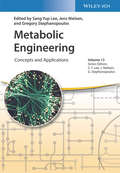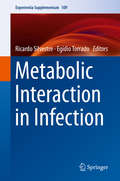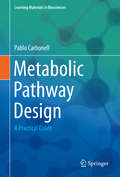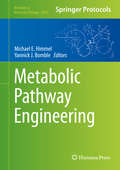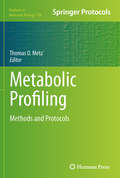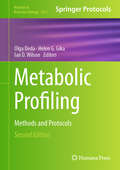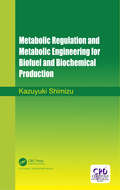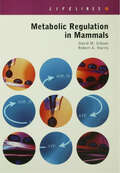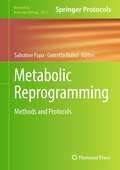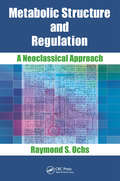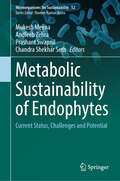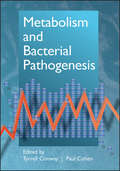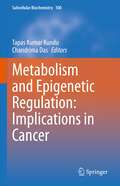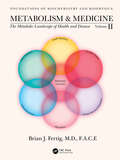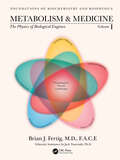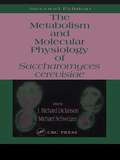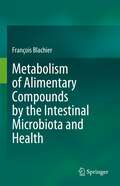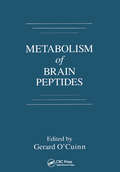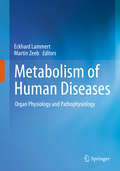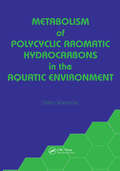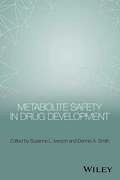- Table View
- List View
Metabolic Engineering: Concepts and Applications (Advanced Biotechnology)
by Sang Yup LeeLearn more about foundational and advanced topics in metabolic engineering in this comprehensive resource edited by leaders in the field Metabolic Engineering: Concepts and Applications delivers a one-stop resource for readers seeking a complete description of the concepts, models, and applications of metabolic engineering. This guide offers practical insights into the metabolic engineering of major cell lines, including E. Coli, Bacillus and Yarrowia Lipolytica, and organisms, including human, animal, and plant). The distinguished editors also offer readers resources on microbiome engineering and the use of metabolic engineering in bioremediation. Written in two parts, Metabolic Engineering begins with the essential models and strategies of the field, like Flux Balance Analysis, Quantitative Flux Analysis, and Proteome Constrained Models. It also provides an overview of topics like Pathway Design, Metabolomics, and Genome Editing of Bacteria and Eukarya. The second part contains insightful descriptions of the practical applications of metabolic engineering, including specific examples that shed light on the topics within. In addition to subjects like the metabolic engineering of animals, humans, and plants, you’ll learn more about: Metabolic engineering concepts and a historical perspective on their development The different modes of analysis, including flux balance analysis and quantitative flux analysis An illuminating and complete discussion of the thermodynamics of metabolic pathways The Genome architecture of E. coli, as well as genome editing of both bacteria and eukarya An in-depth treatment of the application of metabolic engineering techniques to organisms including corynebacterial, bacillus, and pseudomonas, and more Perfect for students of biotechnology, bioengineers, and biotechnologists, Metabolic Engineering: Concepts and Applications also has a place on the bookshelves of research institutes, biotechnological institutes and industry labs, and university libraries. It's comprehensive treatment of all relevant metabolic engineering concepts, models, and applications will be of use to practicing biotechnologists and bioengineers who wish to solidify their understanding of the field.
Metabolic Flux Analysis in Eukaryotic Cells: Methods and Protocols (Methods in Molecular Biology #2088)
by Deepak NagrathThis volume explores the latest metabolic flux analysis (MFA) techniques that cover the analysis of cellular, organ level, and whole-body metabolism. The chapters in this book discuss topics such as deutrium tracing; isotopologue fractions using GC-TOF; non-targeted mass isotopolome analysis; large-scale profiling of cellular metabolic activities using deep 13C labeling medium; metastases in mice; SWATH; Exo-MFA; metabolic flux from time-course metabolomics; and thermodynamic approaches in flux analysis. Written in the highly successful Methods in Molecular Biology series format, chapters include introductions to their respective topics, lists of the necessary materials and reagents, step-by-step, readily reproducible laboratory protocols, and tips on troubleshooting and avoiding known pitfalls. Cutting-edge and comprehensive, Metabolic Flux Analysis in Eukaryotic Cells: Methods and Protocols is a valuable resource for both experts in MFA techniques and researchers getting involved in the role of quantitative studies to uncover the dysregulated pathways in human diseases.
Metabolic Interaction in Infection (Experientia Supplementum #109)
by Ricardo Silvestre Egídio TorradoThis book focuses on host–pathogen interactions at the metabolic level. It explores the metabolic requirements of the infectious agents, the microbial metabolic pathways that are dedicated to circumvent host immune mechanisms as well as the molecular mechanisms by which pathogens hijack host cell metabolism for their own benefit. Finally, it provides insights on the possible clinical and immunotherapeutic applications, as well as on the available experimental and analytical methods. The contributions break new ground in understanding the metabolic crosstalk between host and pathogen.
Metabolic Pathway Design: A Practical Guide (Learning Materials in Biosciences)
by Pablo CarbonellThis textbook presents solid tools for in silico engineering biology, offering students a step-by-step guide to mastering the smart design of metabolic pathways. The first part explains the Design-Build-Test-Learn-cycle engineering approach to biology, discussing the basic tools to model biological and chemistry-based systems. Using these basic tools, the second part focuses on various computational protocols for metabolic pathway design, from enzyme selection to pathway discovery and enumeration. In the context of industrial biotechnology, the final part helps readers understand the challenges of scaling up and optimisation. By working with the free programming language Scientific Python, this book provides easily accessible tools for studying and learning the principles of modern in silico metabolic pathway design. Intended for advanced undergraduates and master’s students in biotechnology, biomedical engineering, bioinformatics and systems biology students, the introductory sections make it also useful for beginners wanting to learn the basics of scientific coding and find real-world, hands-on examples.
Metabolic Pathway Engineering (Methods in Molecular Biology #2096)
by Michael E. Himmel Yannick J. BombleThis book illustrates experimental and computational methodologies used to achieve cost effective biological processes for the production of fuels and biochemicals through multiple approaches to increasing yield, titers, and productivity in a robust host. The volume includes the most recent and cutting-edge aspects of pathway engineering, flux analysis, and metabolic enzyme engineering. Each chapter highlights the complexity and challenges of the problem as well as the methods used to solve this problem or changes needed in current methods. As a part of the highly successful Methods in Molecular Biology series, chapters include the kind of detailed implementation advice that gives researchers a much needed boost. Authoritative and practical, Metabolic Pathway Engineering benefits not only scientists working on more fundamental aspects of this endeavor but also those in the biochemical industry working on strain engineering for robust industrial processes.
Metabolic Profiling
by Thomas O. MetzAt the intersection of metabolite analysis, metabolic fingerprinting, and metabolomics, the study of metabolic profiling has evolved steadily over the course of time as have the methods and technologies involved in its study. In Metabolic Profiling: Methods and Protocols, expert researchers in the field present protocols that are illustrative of the evolution of metabolic profiling from single molecule analysis to global metabolome profiling. Comprised of the most essential techniques, this volume covers topics from inborn errors of metabolism and drug metabolite analysis to nuclear magnetic resonance metabolic profiles. Written in the highly successful Methods in Molecular BiologyTM series format, chapters include introductions to their respective subjects, lists of the necessary materials and reagents, step-by-step, readily reproducible laboratory protocols, and tips on troubleshooting and avoiding known pitfalls. Authoritative and practical, Metabolic Profiling: Methods and Protocols serves as a resource for both established and new investigators in this vital and ever-developing field.
Metabolic Profiling: Methods and Protocols (Methods in Molecular Biology #2891)
by Ian D. Wilson Helen G. Gika Olga DedaThis second edition volume expands on the previous edition with new chapters and updated discussions on the latest advancements in the development and practice of metabolic phenotyping. The chapters in this book cover topics such as quality control in untargeted metabolic phenotyping; implementation of quality assurances processes; careful bio- and chemoinformatic data analysis; using reversed-phase and ion-pair LC-MS; quantitative lipid analysis using supercritical fluid chromatography (SFC-MS) and the targeted determination of metanephrines in urine via LC-MS/MS. Written in the highly successful Methods in Molecular Biology series format, chapters include introductions to their respective topics, lists of the necessary materials and reagents, step-by-step, readily reproducible laboratory protocols, and tips on troubleshooting and avoiding known pitfalls. Thorough and comprehensive, Metabolic Profiling: Methods and Protocols, Second Edition is a valuable resource for all researchers who are interested in incorporating best practices in metabolic phenotyping and learning more about this rapidly advancing field.
Metabolic Regulation and Metabolic Engineering for Biofuel and Biochemical Production
by Kazuyuki ShimizuThe global warming problem is becoming critical year by year, causing climate disaster all over the world, where it has been believed that the CO2 gas emitted from the factories and the burning of fossil fuels may be one of the reasons of global warming. Moreover, the global stock of fossil fuels is limited, and may run out soon within several tens of years. Although wind, geo-thermal, and tide energies have been considered as clean energy sources, those depend on the land or sea locations and subject to the climate change. Biofuel and biochemical production from renewable bio-resources has thus been paid recent attention from environmental protection and energy production points of view, where the current chemical and energy producing plants can be also utilized with slight modification. The so-called 1st generation biofuels have been produced from corn starch and sugarcane in particular in USA and Brazil. However, this causes the problem of the so-called "food and energy issues" as the production scale increases. The 2nd generation biofuel production from lingo-cellulosic biomass or wastes has thus been paid recent attention. However, it requires energy intensive pretreatment for the degradation of lingo-cellulosic biomass, and the fermentation is slow due to low growth rate, and thus the productivity of biofuels and bio-chemicals is low. The 3rd generation biofuel production from photosynthetic organisms such as cyanobacteria and algae has been also paid attention, because such organisms can grow with only sun light and CO2 in the air, but the cell growth rate and thus the productivity of the fuels is significantly low. The main part or core of such production processes is the fermentation by micro-organisms. In particular, it is critical to properly understand the cell metabolism followed by the efficient metabolic engineering. The book gives comprehensive explanation of the cell metabolism and the metabolic regulation mechanisms of a variety of micro-organisms. Then the efficient metabolic engineering approaches are explained to properly design the microbial cell factories for the efficient cell growth and biofuel and biochemical production.
Metabolic Regulation in Mammals (Lifelines Series)
by David Gibson Robert A. HarrisMetabolic Regulation in Mammals presents the basic principles of metabolic control, based on investigations conducted during the past 20 years. It explains the impact of recent advances in cell biology, molecular biology, and genetics on the field. This text covers all angles of metabolic regulation, including blood caloric homeostasis, cardiac and skeletal muscle, adipose tissue, and liver metabolism. Review questions, summary sections, and worked examples help break down the complexity of the subject, and details of metabolic pathways are provided for each body system, along with accompanying charts. This text is ideal for undergraduates in biological and health science disciplines.
Metabolic Reprogramming: Methods and Protocols (Methods in Molecular Biology #2675)
by Salvatore Papa Concetta BubiciThis volume provides state-of-the-art methods and protocols from researchers in the field of metabolism. Chapters guide readers through methodologies measuring different aspects of lipid metabolism, quantifying the amino acids, mitochondrial and intracellular by-products, detect enzyme and kinase activities, detecting a variety of metabolic pathways, and intracellular networks including nucleotide metabolism and the metabolic response to hypoxia and cytotoxic drugs. Written in the format of the highly successful Methods in Molecular Biology series, each chapter includes an introduction to the topic, lists necessary materials and reagents, includes tips on troubleshooting and known pitfalls, and step-by-step, readily reproducible protocols. Authoritative and cutting-edge, Metabolic Reprogramming: Methods and Protocols aims to be a useful and practical guide to new researchers and experts looking to expand their knowledge.
Metabolic Structure and Regulation: A Neoclassical Approach
by Raymond S. OchsThere is a renewed interest in the fundamentals of energy metabolism, yet most people base their understanding on the views of generalists expressed in elementary textbooks. New techniques that enable analysis of thousands of metabolites provide useful data, but do not themselves substitute for an understanding of the fundamentals of metabolism. While classical ideas of metabolism are also valuable, some earlier ideas have not withstood further investigation. This book presents a personal philosophy but rests on what is broadly accepted by metabolic biochemists over the past few decades.
Metabolic Sustainability of Endophytes: Current Status, Challenges and Potential (Microorganisms for Sustainability #52)
by Chandra Shekhar Seth Mukesh Meena Andleeb Zehra Prashant SwapnilThis book describes the diversity and functional roles of fungal endophytes. It explains their beneficial impacts along with the practical applications in crop production. The endophytes are an important possibility for research on future medications and biopesticides in view of the production of secondary metabolites. In the context of agriculture, the book chapters delve into the biostimulant properties of endophytic fungi, offering sustainable solutions for crop production. This extends to their relationships with medicinal plants, paving the way for potential breakthroughs in medicine and agriculture alike. The book encompasses the adaptability and potential of endophytic fungi, emphasizing their future role as biostimulants for the viable bioprospecting of high-value secondary metabolites. Molecular mechanisms governing future host-endophyte interactions is discussed to provide a deeper understanding of signaling pathways. This book is an important asset for future students, researchers in plant science, and professionals across diverse industries, fostering a nuanced comprehension of fungal endophytes and their multifaceted roles in the pursuit of future metabolic sustainability.
Metabolism Engineering Internship: Health Bars for Disaster Relief, Engineering Notebook, with Article Compilation
by The Lawrence Hall of ScienceNIMAC-sourced textbook
Metabolism and Bacterial Pathogenesis (ASM Books #47)
by Paul Cohen Tyrrell ConwayGroundbreaking thinking on how bacterial metabolism is foundational to pathogenesis For too long, bacterial metabolism and bacterial pathogenesis have been studied as separate entities. However, the scientific community is beginning to realize that not only are bacterial nutrient acquisition and utilization essential for pathogenesis, but that interfering with the pathogen-specific metabolic pathways used during infection can regulate virulence factor expression and might lead to effective breakthroughs in a variety of treatments. Editors Paul Cohen and Tyrrell Conway, who pioneered the use of metabolic mutants in competitive colonization assays, an approach now widely used to investigate the nutrition of pathogens in vivo, are uniquely qualified to advance our knowledge of this integrative field of research. They convened a group of contributors who are breaking new ground in understanding how bacterial metabolism is foundational to pathogenesis to share their expert perspectives and outlook for the future. Beginning with overviews, Metabolism and Bacterial Pathogenesis covers a wide range of diseases and both Gram-positive and -negative bacteria that serve as model systems for in vitro and in vivo investigations intracellular, respiratory, and enteric pathogens pathogen-specific nutrient acquisition in hosts mechanisms of host-driven metabolic adaptation by pathogens metabolic regulation of virulence gene expression Useful for specialists in bacterial pathogenesis and specialists in metabolism as well as molecular biologists, physicians, veterinarians, dentists, graduate and undergraduate students, and laboratory technicians, Metabolism and Bacterial Pathogenesis is also essential reading for scientists studying the microbiome.
Metabolism and Epigenetic Regulation: Implications in Cancer (Subcellular Biochemistry #100)
by Tapas Kumar Kundu Chandrima DasMetabolic programs of individuals are key determinants for disease susceptibility and immune response. This book, edited by experts in the field, summarizes epigenetic signaling pathways that regulate metabolic programs associated with cancer and cancer-related secondary diseases.The first part of the book highlights key metabolic pathways that are implicated in cancer and provides a comprehensive overview on the carbohydrate, protein, lipid, amino- and nucleic acid metabolic pathways that are deregulated in cancer. Special attention is paid to the altered tumor micro-environment that is influenced by the metabolic milieu. Furthermore, the fundamental relationship between the cellular metabolic environment and cell death-mediated autophagy is discussed.The second part of the book covers our understanding of the fundamental epigenetic regulations that are implicated in controlling the metabolic programs in cancer cells. Many aspects of epigenetic regulation of non-coding RNAs as well as DNA/RNA methylation, which influencing metabolic homeostasis in cancer, are discussed in detail. Special emphasis is placed on the epigenetic regulation of the amino acid, glucose/carbohydrate metabolism and epigenetic regulation during hypoxia and its connection to cancer.Last but not least, the third part of the book covers small molecule modulators of histone modifying enzymes, which can be used as therapeutic tools. The readers learn about the cross-talk between epigenetics and immunometabolims, as well as the epigenetic regulation of oncometabolites to combat cancer. Given its scope, the book will appeal to a broad readership interested in epigenetic, cancer and metabolic research.
Metabolism and Medicine: The Metabolic Landscape of Health and Disease (Volume 2) (Foundations of Biochemistry and Biophysics)
by Brian FertigChronic disease states of aging should be viewed through the prism of metabolism and biophysical processes at all levels of physiological organization present in the human body. This book connects these insights to what causes them to go awry in the context of unhealthy human behaviors and aging, aiming to buttress scientific creativity. It also provides links between the art and science of medicine that strengthens problem-solving in patient care. New and important discoveries in the area of metabolic health and metabolic diseases are discussed in exquisite detail. Key Features: Broad and up-to-date overview of the field of metabolic aspects of health and chronic disease development, especially connecting the spectrum of topics that range from molecular clocks to stress response to nuclear hormone receptors and the role of microbiota in human health Provides a deeper basic science and interdisciplinary understanding of biological systems that broaden the perspectives and therapeutic problem solving by elaborating on the usefulness of the Physiological Fitness Landscape Describes the importance of insulin resistance in metabolic disease, especially diabetes but also includes links to cancer and Alzheimer’s disease Examines the process of aging from the perspective of metabolic decline illustrating it with the Physiological Fitness Landscape This book, the second volume in a two-volume set, primarily targets an audience of clinical and science students, biomedical researchers and physicians who would benefit from understanding each other’s language.
Metabolism and Medicine: The Physics of Biological Engines (Volume 1) (Foundations of Biochemistry and Biophysics)
by Brian FertigChronic disease states of aging should be viewed through the prism of metabolism and biophysical processes at all levels of physiological organization present in the human body. This book describes the building blocks of understanding from a reasonable but not high-level technical language viewpoint, employing the perspective of a clinical physician. It brings together concepts from five specific branches of physics relevant to biology and medicine, namely, biophysics, classical electromagnetism, thermodynamics, systems biology and quantum mechanics. Key Features: Broad and up-to-date overview of the field of metabolism, especially connecting the spectrum of topics that range from modern physical underpinnings with cell biology to clinical practice. Provides a deeper basic science and interdisciplinary understanding of biological systems that broaden the perspectives and therapeutic problem solving. Introduces the concept of the Physiological Fitness Landscape, which is inspired by the physics of phase transitions This first volume in a two-volume set, primarily targets an audience of clinical and science students, biomedical researchers and physicians who would benefit from understanding each other’s language.
Metabolism and Molecular Physiology of Saccharomyces Cerevisiae
by J. Richard Dickinson Michael SchweizerSince the publication of the best-selling first edition, much has been discovered about Saccharomyces cerevisiae, the single-celled fungus commonly known as baker's yeast or brewer's yeast that is the basis for much of our understanding of the molecular and cellular biology of eukaryotes. This wealth of new research data demands our attention and r
Metabolism of Alimentary Compounds by the Intestinal Microbiota and Health
by François BlachierThis book provides an overview of the metabolism of dietary compounds by the intestinal microbiota, and on the consequences of such metabolic activity on host metabolism and physiological functions; both in intestinal and peripheral tissues.Over the last years, our understanding of the causal links between microbiota metabolic activity towards dietary and endogenous substrates and human health status has evolved extensively. In this context, the book starts with a comprehensive introduction devoted to the physiological and metabolic functions of the intestinal epithelium, followed by a part dedicated to the way intestine offers board and lodging for microbes being on a short- or long-term stay. The next chapters focus on the utilization of the available substrates from diet by the intestinal bacteria to produce numerous bacterial metabolites, and on the impact of such microbial activity, in the first place for communication between microbes, and for communication between microbes and lodging host. As will be detailed, this latter process of interkingdom communication leads to either beneficial or deleterious effects on intestinal physiology and metabolism. Special attention is given to selected pathophysiological processes namely chronic intestinal inflammation, colorectal carcinogenesis, and diarrhea. Then, the effects of modifications of bacterial metabolites and other bioactive compounds by the host after intestinal absorption, and consequences for peripheral tissue functions are presented.Summarizing the state of the art on what is known about the metabolic crosstalk between gut microbiota and human metabolism, as well as perspectives for further experimental and clinical research, this book provides a useful resource for researchers, professionals, and students with a background in biology, and/or nutrition, medicine, pharmacology, and for those which are involved in the agriculture and food production. By explaining technical terms all along the text, this book should be understandable also for interested non-specialists.
Metabolism of Brain Peptides
by Gerard O'CuinnMetabolism of Brain Peptides discusses neuropeptide metabolism in light of recent research. It describes the processing mechanisms in the production of biologically active peptides. It details distribution of the variety of neuropeptides in the brain and comprehensively reviews the effects of these neuropeptides on behavioral and physiological functions. The book also examines termination mechanisms for the biological activities of neuropeptides in light of recent knowledge of their distribution, their receptors and their possible inactivation enzymes in various functional regions of the brain and at the blood-brain barrier.
Metabolism of Human Diseases
by Eckhard Lammert Martin Zeeb"Metabolism of Human Diseases" examines the physiology of key organs (e. g. brain, eye, lung, heart, blood vessels, blood, immune system, gastrointestinal tract, pancreas, liver, fat tissue, kidney, reproductive system, teeth, bone and joints) and how defective metabolism and signaling pathways within these organs contribute to common human diseases. The latter include depression, schizophrenia, epilepsy, Parkinson's disease, Alzheimer's disease, migraine, multiple sclerosis, Down syndrome, macular degeneration, glaucoma, asthma, COPD, pneumonia, atherosclerotic heart disease, heart failure, stroke, varicose veins, Sickle cell disease, hyperlipidemia, fever, sepsis, allergies, peptic ulcer, gastroenteritis, lactose intolerance, colon cancer, diabetes, cirrhosis, metabolic syndrome, hypertension, chronic kidney disease, gout, urinary tract infections, kidney stones, dental caries, osteoporosis, osteoarthritis, rheumatoid arthritis, breast cancer and prostate cancer. The book also describes commonly used drugs and explains their molecular targets. It provides the first comprehensive and detailed summary of the metabolism of individual organs and their physiological and pathological functioning. Thus it serves as a useful supplement to previous textbooks of human physiology "Metabolism of Human Diseases" is a must-have, state-of-the-art textbook written by International experts for graduate students, postdocs and scientists in metabolic research, biochemistry, physiology and pharmacy as well as for physicians interested in molecular mechanisms underlying common human diseases.
Metabolism of Polycyclic Aromatic Hydrocarbons in the Aquatic Environment
by Usha VaranasiThis book shows how the biological transport, bioaccumulation, disposition, and toxicity of polycyclic aromatic hydrocarbons (PAH) in the aquatic environment are influenced by the ability or inability of organisms to metabolize these environmental pollutants. Written by leading scientists in the fields of PAH metabolism and toxicity in both aquatic and mammalian systems, this book discusses recent advances in the areas of PAH biogeochemistry and bioaccumulation, microbial degradation, enzymes of activation, and detoxication, metabolism of PAH, and laboratory and field studies on carcinogenic/toxic effects. Additionally, important similarities and differences in metabolism of PAH by aquatic and terrestrial organisms are featured. The discussion of bioavailability, metabolism, and subsequent toxic effects should aid in the assessment of the ecological consequences of PAH in the aquatic environment.
Metabolism: Making the Diagnosis, Investigation Notebook [Grade 6]
by The Lawrence Hall of ScienceNIMAC-sourced textbook
Metabolism: Making the Diagnosis, Investigation Notebook with Article Compilation
by The Lawrence Hall of ScienceNIMAC-sourced textbook
Metabolite Safety in Drug Development
by Dennis A. Smith Suzanne L. IversonA reference on drug metabolism and metabolite safety in the development phase, this book reviews the analytical techniques and experimental designs critical for metabolite studies. It features case studies of lessons learned and real world examples, along with regulatory perspectives from the US FDA and EMA.* Reviews the analytical techniques and experimental designs critical for metabolite studies* Covers methods including chirality, species differences, mass spectrometry, radiolabels, and in vitro / in vivo correlation* Discusses target pharmacology, in vitro systems aligned to toxicity tests, and drug-drug interactions* Includes perspectives from authors with firsthand involvement in industry and the study of drug metabolites, including viewpoints that have influenced regulatory guidelines
